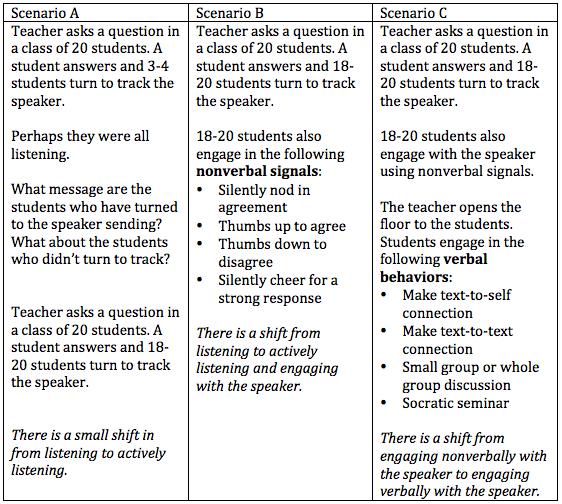Teachers often insist that it doesn’t matter if the student is tracking or looking at the speaker. “I can listen and not look at you,” are the words that made me stop and pause. The 25-year veteran teacher was absolutely right. She could listen without looking at me, as we were only 12 inches apart. In fact, many people do exactly that throughout most of their day. Why was I requiring what seemed to be an exercise in compliance from every student in the class?
As a Managing Associate for CT3, I get asked this question quite frequently. I realized teachers are asking this question because they aren’t seeing the bigger picture of what’s happening in their classroom. Here’s my attempt to break down “tracking the speaker”.
“The Tracking Continuum”
Picture a classroom where students are seated and all silently listening to the speaker. In this case, it’s the teacher speaking. Why would you want the students to track the speaker? Most teachers rattle off the following answers:
- Showing respect for the person speaking
- One way to show the student is listening
- Visual check for the teacher
- Relationship building
- Life skill for both professional and personal settings
- Tool for students who are acquiring English as a second language
Sure, all of these make sense. However, there’s more to tracking than what’s listed above. Consider the scenarios below:
Is there a time for each scenario to be used effectively in a classroom? Yes! Consider using Scenario 1 with test review where students are answering quickly. Also consider the seating arrangement. If students are seated with their backs to their classmates, it makes tracking the speaker a challenge. To keep the momentum in the classroom high and impact student engagement, teachers most often use Scenario 2. After students have built a culture in the classroom of tracking the speaker and sending nonverbal signals, they are ready for Scenario 3.
In essence, Scenario 3 is the rationale behind tracking as students are able to interact freely and respond critically to questions and responses prompted by both the teacher and fellow classmates. Vygotsky (1962) suggested that thinking develops into words in a number of phases, moving from imaging to inner speech to inner speaking to speech. Tracing this idea backward, speech—talk—is the representation of thinking. Classrooms with more opportunities for Scenario 3 are enriched with students thinking and carrying the cognitive load versus the traditional classrooms where the teacher is doing the majority of the talking aka “thinking”.
By the time I introduced the veteran teacher to Scenario 2, she was excitedly on board with “why tracking” is not so small after all. These actions were not new to the teacher. She was well-versed in having students use nonverbal methods to increase participation. The newness came with the connection of tracking as a prerequisite for more elaborate methods of engaging students. As I wrapped up scenario 3, her head nods were stronger and she wanted to create a chart to share with others who are still postulating over tracking. She left me with these words, “I guess I just expected them to do it. Instead, we should explicitly share why tracking matters and let students know what comes next.”
If your students are already tracking the speaker, consider moving between Scenario 2 and 3. Ask your students, what will you do if you are unable to track the speaker? How will you remain engaged? How will you let the speaker know that you are engaged?
by Eyka Stephens, Managing Associate, CT3
As a teacher and reading specialist in Miami-Dade Public Schools, Eyka has seen first-hand the transformative potential of excellent teaching. A veteran of urban education, Eyka brings more than 15 years’ experience working in underserved communities.
Check out CT3 Education programs such as No-Nonsense Nurturer, Real Time Teacher Coaching, and Real Time Leadership Coaching to find out more about Professional Development for Teachers and Leaders, classroom management strategies, and building relationships with students and their families, and properly addressing important issues in the classroom and school.
Category: Education, Teaching


